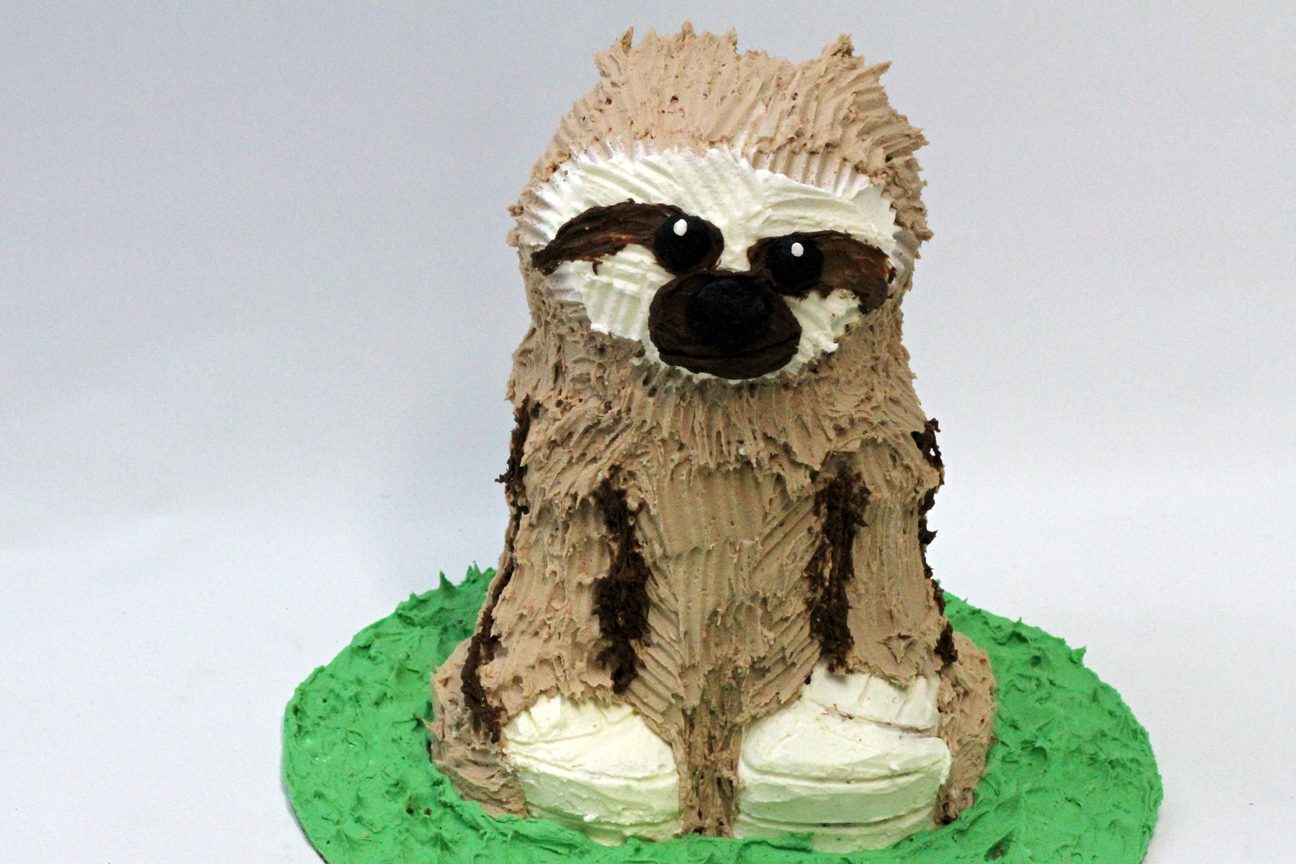
I’m excited to shared this adorable and easy sloth cake with you! It looks like it would be difficult and time consuming to make but it’s actually very simple, requiring basic tools and it’s surprisingly quick to assemble, frost and decorate!
Start by assembling your cake on a cake board a few inches bigger than the cake. Use a generous dollop of buttercream to secure your first layer of cake to the cake board.

Alternate cake and fillings to assemble your cake. I’m using my Perfect Chocolate Cake and my 4 Minute Buttercream mixed with melted chocolate. I freeze my cake layers before I start and I’ll explain why in a moment.
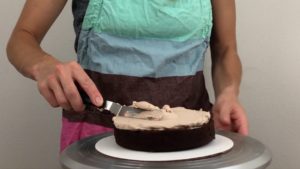
I’m using nine 6″ cake layers for this and they’re each about an inch and a half tall. You can make this much smaller by using smaller cake layers or even turn cupcakes into cake by cutting them half horizontally!
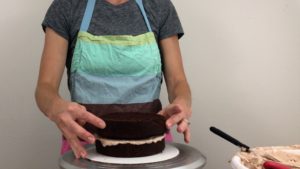
You’ll need support for every 6 inches of height. You can use straws (boba straws work best because they’re wider and stronger than regular straws) or dowels. Push one down into the cake, all the way down until it hits the cake board.
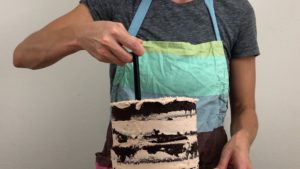
Pinch the point where the straw or dowel reaches the top of the cake, pulling it out and cutting it at that point. This way it’s the same height as the cake.
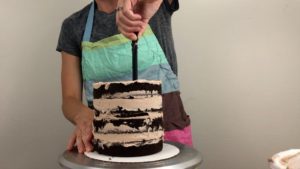
Hold that first straw or dowel against 3 more straws or dowels to measure them to be exactly the same height. If your cake is going to be less than 6 inches tall you can skip the support straws or dowels or use one cake board in the middle of the cake and use a tripod structure of just 3 supports.

Cut all of your straws or dowels and then push them into the cake to make support beams for the cakes that will sit on top. I use 4 supports for a 6” cake, which will easily serve 30-40 people, but for larger cakes I’d use a more secure system.

When you place these straws or dowels in the cake, you’ll need them to be about 2 inches in from the edge of the cake so that they’re anchored securely in the cake and so that you can trim the cakes you place on top but they’ll still be sitting on these straws.
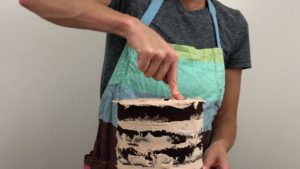
Place another cake board on top of the cake you’ve assembled so far and spread on some buttercream to attach your next layer of cake. This board should be an inch or two smaller than the cakes because you’re going to trim the cakes in a minute.
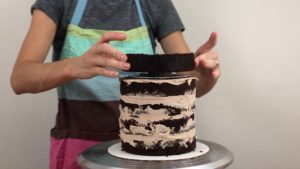
The cake board will rest on top of the straws or dowels so that any weight you put on top with these next cake layers will be supported by the straws or dowels, so they won’t press down on the cake below the board and those cakes won’t sink down.

Continue layering your cake and filling, making sure that each layer is sitting straight on top of the previous layer so that the cake doesn’t tilt to one side. When you’re finished, it’s time to shape the cake!
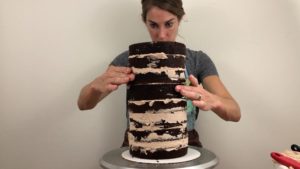
Use a serrated knife to carve the top section into a sphere, which will be the head of the sloth. It’s easiest to carve cakes when they’re cold because they’re firmer and less crumbly, which is why I’m using frozen cake layers.
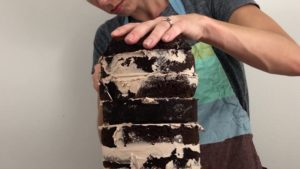
By the time you’ve assembled your cake and you’re ready to carve it, the layers will have started to thaw so they won’t be so frozen that they’re difficult to cut, but they’ll still be nice and cold to make for easy carving. If you have space in a fridge or freezer big enough to chill the cake after assembling it but before carving it, that’s perfect, you don’t have to use frozen cake layers then, but I’m assuming you don’t have that much space!

To carve a sphere I start by cutting at diagonals to trim off large sections of the cake to make a very angular round shape, and then use smaller cutting motions to trim those down to round them out and make a curved surface of cake.

Even with hundreds of these back and forth carving motions, the cake might wobble but the top section is staying securely on top of the bottom section because of the support straws, so it’s not going to lean over to one side even with this pressure against it.

Now mark where the arms are going to be, choosing where the inner edge of each arm will be and scoring a line downwards as a guide and then carving out a bit of cake there to make an indent.
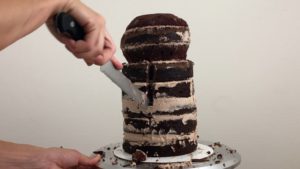
Take your final layer of cake and cut it in half to make two semi circles and these will be the sloth’s legs. Trim the flat edge to make it curved so that it will sit right up against the body.
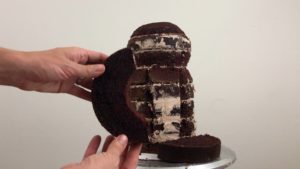
Spread some buttercream onto the bottom of the cake and on the side you’ve just trimmed to act as glue to attach it to the side of the cake and to stick down onto the cake board.
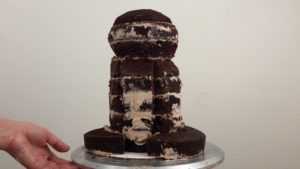
Trim the cake “legs” so that they’re not hanging over the edge of the cake board and use the offcuts to make the hands, resting on top of the feet, attaching them with a bit more buttercream. Don’t worry about carving these to be smooth because you’re going to cover this all up with buttercream fur later, which will give the legs the shape you want.
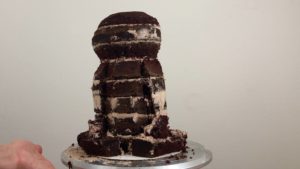
You’ll need more buttercream for the frosting, a little bit of plain white but mostly brown. I’m using chocolate to make my buttercream brown for the fur but you can use brown coloring instead. I’ll talk about options for your cake board in a moment.

Spread white buttercream onto the middle of the sloth’s face, just a thin layer as a crumb coat to trap in any crumbs that come off the cake so that they don’t get into your final coat of frosting.

Spread brown buttercream over the rest of the cake except for the hands and feet, which we’re going to make white as well. Since the cake should still be cold, it should be easy to spread buttercream onto it without pulling crumbs off but if you’re struggling, add some milk or cream to your buttercream to thin it out and then it should be easier to spread.
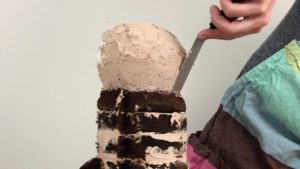
Spread the buttercream side to side over the cake, lifting your spatula the fewest times possible and when you do have to lift the spatula off to get more buttercream, swipe it off sideways instead of lifting it straight off the cake because that might pull crumbs or chunks of cake off with it.
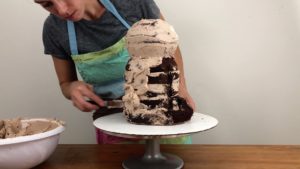
Now, about the cake board. The board needs to be big enough to fit the original cake layers, so 6” wide for my cake, but also a few inches bigger so fit the legs that you add on afterwards. You’ll want it to be a few inches bigger than that so that there’s a boarder around the cake where you can add grass or a message.

So for my cake, made with 6” cake layers, I’m placing the cake on a 12” cake board. If you have a cake drum, which is thicker and stronger, that’s best so that it supports the weight of the cake but if you don’t, you can build the cake on one cake board and attach that to another cake board with a little roll of masking tape, so that it’s thicker and stronger.

After covering your cake completely with the first layer of buttercream, let the buttercream set for about 30 minutes and meanwhile, making the facial details of the sloth. Put some black buttercream in a ziploc bag with a corner cut off or a piping bag fitted with a small round tip.
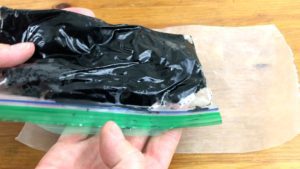
Squeeze some buttercream out of the bag into a circle on a piece of wax paper, or you can use parchment paper instead. You’ll need 3 circles: a big one for the nose and two slightly smaller ones for the eyes.

Chill these in the fridge or freezer for a few minutes until they start to set and then use a piece of parchment or wax paper to flatten and smooth the top surface of each circle.
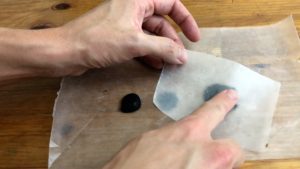
Use the end of a paintbrush or another round pointed object to imprint two nostrils into the sloth’s nose.

Then use white buttercream in a ziplock bag with the corner cut off to pipe little white reflections on the eyes, or your can use a piping bag with a small round tip instead.

Then use white buttercream in a ziplock bag with the corner cut off to pipe little white reflections on the eyes, or your can use a piping bag with a small round tip instead. Put them back in the fridge or freezer when you’ve finished.

When the crumb coat on the sloth has set, which means any crumbs that have come off the cake will be trapped in that coat of frosting, spread another layer of buttercream over the top.
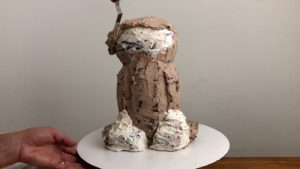
Do this a section at a time so that the buttercream doesn’t set before you imprint fur into it. I’m starting with the head, using brown buttercream everywhere except on the front of the face
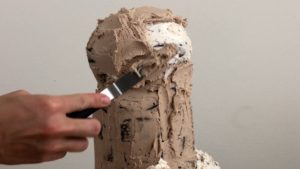
Now use a zig zag textured cake comb to imprint fur into the buttercream, scraping from the white part of the face out towards the brown to blend the colours together gradually.

Use the textured cake comb all over the white part of the face and the rest of the brown head. If you don’t have a zig zag cake comb like this you can use a fork instead.

As you’re using the comb, if you scrape through the buttercream to expose the cake underneath just spread on a bit more buttercream and then use the textured comb over that area again.

Before I continue with the body I’m going to add the details to the face, starting by using this chocolate buttercream that I’ve added a LOT more melted chocolate to, to make it a darker shade of brown. You could do this at the end but I’m excited to see how the face will turn out!
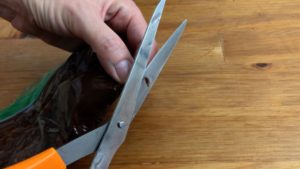
Pipe the dark brown buttercream onto the face to make brown patches around the eye. I’m using a ziplock bag for this to show you how to do this with minimal tools but you could use a piping bag and round tip instead.

Spread the buttercream with an
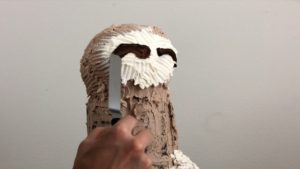
Add a big patch of dark brown for the snout of the sloth, either squeezing a bib dollop of buttercream out of the bag or piping several rings to fill in the shape.
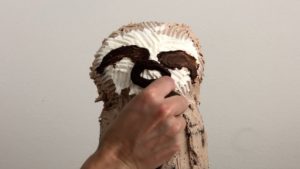
Immediately after piping the eye markings and the nose, while this buttercream is still fresh and sticky, take the eyes and nose out of the fridge or freezer and peel them off the paper and press them into the buttercream.
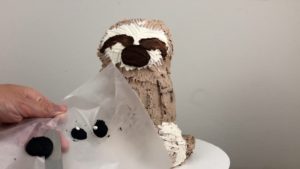
Make sure the white dots in the eyes are pointing in the same direction, unless you want your sloth to look cross eyed or confused!

Now move down to the body of the sloth. I’m doing the white parts first, the hands and feet, spreading the buttercream fairly smoothly with my offsets spatula and then imprinting the fingers or toes with a chopstick.
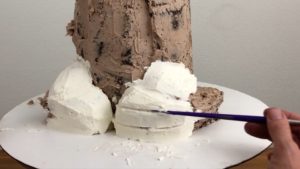
You could use the edge of your

Spread brown buttercream onto the rest of the body to completely cover it, spreading quite thickly but not worrying about getting it smooth at all because you’re going to use your textured cake comb over the top to make it look like fur.
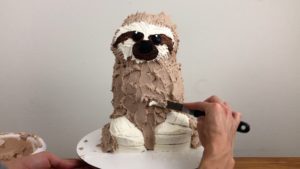
I love this technique for making fur because it’s super easy but also so intentionally messy that you can’t really mess it up – if you don’t scrape deep enough into the frosting with your comb you can just scrape over the area again more deeply and if you scrape too deeply, just spread on some more buttercream to cover the area and then scrape again!
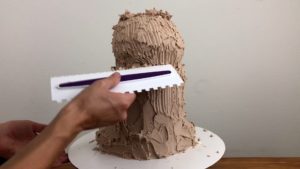
For the section of the body in between the feet, it’s too narrow to fit my cake comb comfortably so I’m using the end of a paintbrush (or you could use a chopstick) to scratch grooves for the fur instead.
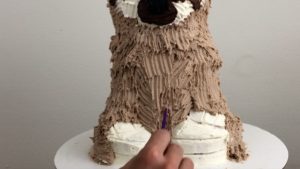
To cover up the cake board, spread green buttercream all over the cake board with an

Use your
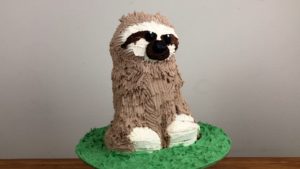
The final detail for this cake is to make the arms more obvious. Although you carved them out of the cake body, with all of the frosting on top they’ve probably got a bit lost in the rest of the sloth’s body. Use the very dark brown buttercream that you used for the face, piping a thin line of it down each side of each arm.
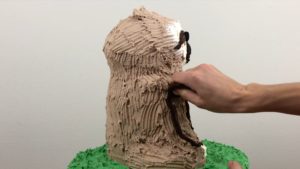
Use the end of a paintbrush or a chopstick or
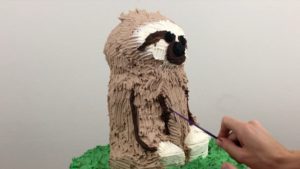
And there he is! My adorable sloth cake, made entirely of cake and buttercream frosting! I’d recommend keeping this in the fridge
until two to four hours before you eat it and if you’re going to transport it, keep it in the fridge until you go.
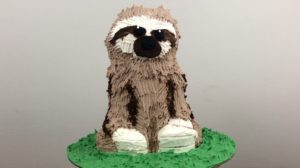
Here’s the video version of this tutorial:
